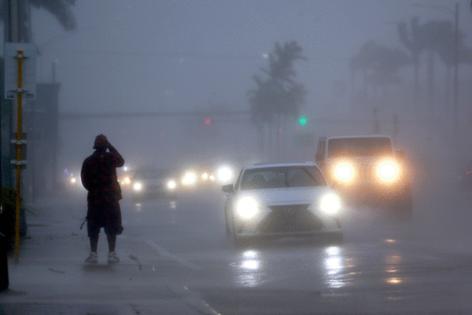PFAS 'forever chemicals' found in Florida rain, study says
Published in Science & Technology News
FORT LAUDERDALE, Fla. — A recent study by Florida International University found 21 types of PFAS “forever chemicals” in South Florida’s rainwater. The evidence in the study suggests that some of the PFAS that end up in South Florida are carried over vast distances in the atmosphere via the water cycle.
There are thousands of types of PFAS (per- and polyfluoroalkyl substances) used in a wide range of products, including non-stick pans, carpeting, waterproof clothing, food packaging, firefighting foam, batteries and microelectronics.
The particles are small enough for people to ingest or inhale, and some varieties have been linked to liver and kidney damage, fertility issues, cancer and other diseases. But much remains unknown about many others.
One common denominator is that they can take thousands of years to break down, and can be found in water, food, and human blood across the globe.
The Environmental Protection Agency says it is “working hard to answer critical questions about PFAS.” Meanwhile, they have become a global issue.
In order to help understand PFAS sources in South Florida, FIU researchers took 42 rain samples at three locations in Miami-Dade County throughout the year from October 2021 to November 2022. They found that South Florida rainwater had various PFAS in it.
Sometimes the specific PFAS compounds matched local sources, but in the dry season (October through May), there was a spike in PFAS that likely came from distant regions of the U.S.
Those spikes coincided with the timing of northern air masses moving south into Florida. The various PFAS at that time matched those from chemical plants in northern regions.
FIU researchers Natalia Soares Quinete and Maria Guerra de Navarro, two of the authors on the study, suspect that dry weather makes it easy for wind to pick up particles, and then the prevailing weather of the dry season carries those particles toward Florida. When it rains here, the chemicals are washed out of the sky.
“PFAS are practically everywhere,” Quinete said. “Now we’re able to show the role air masses play in potentially bringing these pollutants to other places where they can impact surface water and groundwater.”
How far can the chemicals travel? “There are studies that have found these compounds in polar bears in very remote areas,” Quinete said.
Additionally, water containing PFAS in Florida can evaporate and the particles can travel elsewhere, continuing the cycle.
Quinete said that finding PFAS in rain water was not a surprise, but “the data is important because the PFAS can be coming from faraway areas. Here in Florida, we don’t really have PFAS manufacturing industries, but we are seeing typical (PFAS types) that we are tracing to areas in the north.”
The research team used airmass modeling to backtrack the path of the airmasses that were in South Florida when they saw peaks in PFAS. Those airmasses came from the north during the dry season.
Guerra de Navarro said that two PFAS types — PFOA and PFOS — are the compounds known to be the most harmful to humans at this point. Both were used in non-stick cookware, some waterproof clothing, stain-resistant fabrics and firefighting foam.
PFOA was banned in the U.S. in 2014 and globally in 2020, but it is still cycling through our environment.
The EPA designated PFOS as a hazardous substance in April of 2024. “Public water systems must begin monitoring for PFOS by 2027 and take action to reduce levels if they exceed certain limits by 2029,” the EPA website said.
“We did find PFOA and PFOS (in Miami-Dade rainwater),” Guerra de Navarro said, “and we know that they are very toxic.” Their PFOA measurements were above safe drinking water levels in some locations, but not all the time, she said, and it could be coming from both local and far-off sources.
Miami-Dade County’s population densities make it more susceptible to PFAS than rural areas of Florida, but the weather patterns that affect Miami-Dade also affect Broward and Palm Beach counties.
“We wanted to show what you do in one place can affect others,” Quinete said. “We should be taking a more holistic approach, nationally and internationally to reduce PFAS.”
_____
©2024 South Florida Sun Sentinel. Visit at sun-sentinel.com. Distributed by Tribune Content Agency, LLC.







Comments